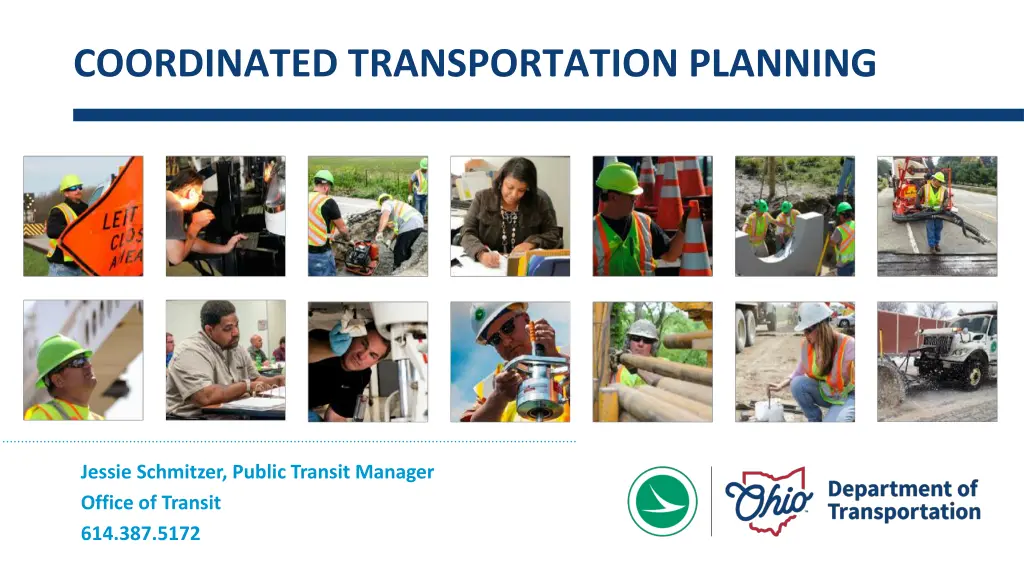
Coordinated Transportation Planning for Enhanced Mobility Services
Discover the essence of coordinated transportation planning led by Jessie Schmitzer, focusing on improving services for transportation-disadvantaged individuals in Ohio. Explore current programs, funding sources, and the strategic framework to ensure efficient and accessible transportation services in the region.
Download Presentation

Please find below an Image/Link to download the presentation.
The content on the website is provided AS IS for your information and personal use only. It may not be sold, licensed, or shared on other websites without obtaining consent from the author. If you encounter any issues during the download, it is possible that the publisher has removed the file from their server.
You are allowed to download the files provided on this website for personal or commercial use, subject to the condition that they are used lawfully. All files are the property of their respective owners.
The content on the website is provided AS IS for your information and personal use only. It may not be sold, licensed, or shared on other websites without obtaining consent from the author.
E N D
Presentation Transcript
COORDINATED TRANSPORTATION PLANNING Jessie Schmitzer, Public Transit Manager Office of Transit 614.387.5172
TRANSPORTATION FUNDING Formula Funds State GRF Large/Small Urban Transit Agencies Ohio Transit Agencies 3 |
CURRENT PROGRAMS FTA & STATE GRF Rural Transit Program (5311) Specialized Transportation Program (5310) Bus & Bus Facilities (5339) Ohio Transportation Partnership Program (OTP2) Urban Transit Program (UTP) Ohio Mobility Management Program (MM) Ohio Workforce Mobility Partnership Program (OWMP) Facility Program Low-No Emissions Program Ohio Rural Zero Emissions Program (ORZEP) S/TIP for Transit Flex Fund Transfers for both urban and rural projects Governor s Apportionment (5307 & 5339) Rural Transportation Assistance Program (5311b) Intercity Bus (5311f) Diesel Emissions Reduction Grant (DERG) State of Good Repair (5309) State Safety Oversight (5329) Transportation Development Credits (TDC) 4 |
COORDINATED TRANSPORTATION PLANNING
COORDINATED TRANSPORTATION PLANNING A Coordinated Transportation Plan is a strategic framework developed to improve transportation services for individuals who are transportation disadvantaged, such as seniors, people with disabilities, low-income individuals, and other underserved populations. The goal is to increase the efficiency, accessibility, and availability of transportation services by coordinating resources, services, and transportation providers within a given region. For applicants of FTA Section 5310 funding, a CP is a requirement. 6 |
COORDINATED TRANSPORTATION PLANNING 1. Assessment of Transportation Needs 2. Inventory of Existing Services 3. Identification of Gaps and Barriers 4. Strategies for Coordination 5. Action Plan & Implementation 6. Evaluation and Monitoring 7 |
COORDINATED TRANSPORTATION PLANNING 1. Assessment of Transportation Needs Community Surveys General Public, Seniors, Individuals with Disabilities, Non-Profit Organizations, Employers Public roundtables On-board surveys Local Demographic and Socio-Economic Data Density of Zero Vehicle Households Major Trip Generators 8 |
COORDINATED TRANSPORTATION PLANNING 2. Inventory of Existing Services Lists both public and private providers Surveys / Interview with providers Type of services provided, days/hours of service Service area Eligibility requirements Accessible vehicle information 9 |
COORDINATED TRANSPORTATION PLANNING 3. Identification of Gaps & Barriers Utilizing survey responses and data to identify the gaps and barriers within the community Early/late service gaps Weekend service gaps Out of county service availability Excessive pre-booking periods Accessible services Lack of local funding 10 |
COORDINATED TRANSPORTATION PLANNING 4. Strategies for Coordination 5. Action Plan and Implementation Addressing the identified service gaps and/or unmet needs Goals and descriptions Timelines for implementation Action Steps Parties responsible for implementation Parties responsible for supporting implementation Resources needed Potential cost 11 |
COORDINATED TRANSPORTATION PLANNING 6. Evaluation & Monitoring These plans are meant to be treated as a live document, not to sit on a shelf They must be reviewed annually and updated Certain changes will require an amendment Must be completely updated every four (4) years 12 |
COORDINATED TRANSPORTATION PLANNING Locally Developed, Coordinated Public Transit- Human Services Transportation Plans For more information, Coordinated Plan templates, guidance, a review checklist and a toolbox visit: Coordinated Transportation Plans | Ohio Department of Transportation 13 |
MOBILITY MANAGEMENT - MISSION Mobility Management (MM) Projects are capital projects that increase access to mobility for Ohioans by: 1. 2. 3. Increasing understanding and awareness of transportation needs Promoting coordination of transportation options to meet needs Building sustainable and healthy communities by integrating transportation into planning and programs 15 |
MOBILITY MANAGEMENT 16 |
MOBILITY MANAGEMENT - MISSION MMs serve as the boots on the ground in local communities Assisting the public directly to connect them to transportation providers Serve as a local advocate within their communities on behalf of transportation needs Host, at least quarterly, publicly open Transportation Advisory Committee (TAC) meetings Lead the Coordinated Planning process and implementation Direct transit training to the public and to local organizations Producing publications about allthe available transportation options in the community. 17 |
MOBILITY MANAGEMENT CP LEADS MMs lead the local CP Process They must form a Coordinated Plan committee the includes non-profits, employers, members of the public, seniors, and individuals with disabilities The committee must develop and approve surveys, plan development, and ultimately the entire plan and any annual review and/or updates MMs host and lead the public meetings, write the plan, develop survey strategies and outreach MMs present the plan and process to local elected officials MMs are responsible for implementation of the goals identified 18 |
MM & CP The MM program is publicly available to all community members and local organizations/businesses They serve as the local transit expert in the areas they serve, and often work together to address regional need Mobility Managers Contact List | Ohio Department of Transportation 19 |
